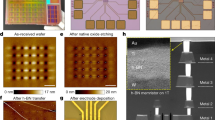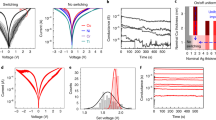Abstract
Two-dimensional materials could play an important role in beyond-CMOS (complementary metal–oxide–semiconductor) electronics, and the development of memristors for information storage and neuromorphic computing using such materials is of particular interest. However, the creation of high-density electronic circuits for complex applications is limited due to low device yield and high device-to-device variability. Here, we show that high-density memristive crossbar arrays can be fabricated using hexagonal boron nitride as the resistive switching material, and used to model an artificial neural network for image recognition. The multilayer hexagonal boron nitride is deposited using chemical vapour deposition, and the arrays exhibit a high yield (98%), low cycle-to-cycle variability (1.53%) and low device-to-device variability (5.74%). The devices exhibit different switching mechanisms depending on the electrode material used (gold for bipolar switching and silver for threshold switching), as well as characteristics (such as large dynamic range and zeptojoule-order switching energies) that make them suited for application in neuromorphic circuits.
This is a preview of subscription content, access via your institution
Access options
Access Nature and 54 other Nature Portfolio journals
Get Nature+, our best-value online-access subscription
$29.99 / 30 days
cancel any time
Subscribe to this journal
Receive 12 digital issues and online access to articles
$119.00 per year
only $9.92 per issue
Buy this article
- Purchase on Springer Link
- Instant access to full article PDF
Prices may be subject to local taxes which are calculated during checkout




Similar content being viewed by others
Data availability
The data that support the plots within this paper and other findings of this study are available from the corresponding author upon reasonable request.
References
Li, M.-Y. et al. How 2D semiconductors could extend Moore’s law. Nature 567, 169–170 (2019).
Akinwande, D. et al. Graphene and two-dimensional materials for silicon technology. Nature 573, 507–518 (2019).
Lee, J. S. et al. Wafer-scale single-crystal hexagonal boron nitride film via self-collimated grain formation. Science 362, 817–821 (2018).
Li, X. et al. Large-area synthesis of high-quality and uniform graphene films on copper foils. Science 324, 1312–1314 (2009).
Lin, Z. et al. Solution-processable 2D semiconductors for high-performance large-area electronics. Nature 562, 254–258 (2018).
Zhang, X. et al. Two-dimensional MoS2-enabled flexible rectenna for Wi-Fi-band wireless energy harvesting. Nature 566, 368–372 (2019).
Cheng, C.-C. et al. First demonstration of 40-nm channel length top-gate WS2 pFET using channel area-selective CVD growth directly on SiOX/Si substrate. In Symposium on Very Large Scale Integration (VLSI) Technology Digest of Technical Papers T244–T245 (IEEE, 2019).
Smets Q. et al. Ultra-scaled MOCVD MoS2 MOSFETs with 42 nm contact pitch and 250 µA/µm drain current. In International Electron Devices Meeting (IEDM) 23.2.1–23.2.4 (IEEE, 2019).
Wang, C.-Y. et al. 2D layered materials for memristive and neuromorphic applications. Adv. Electron. Mater. 6, 1901107 (2020).
Wang, M. et al. Robust memristors based on layered two-dimensional materials. Nat. Electron. 1, 130–136 (2018).
Pan, C. et al. Coexistence of grain-boundaries-assisted bipolar and threshold resistive switching in multilayer hexagonal boron nitride. Adv. Funct. Mater. 27, 1604811 (2017).
Shi, Y. et al. Electronic synapses made of layered two-dimensional materials. Nat. Electron. 1, 458–465 (2018).
Yao, J. et al. Highly transparent nonvolatile resistive memory devices from silicon oxide and graphene. Nat. Commun. 3, 1101 (2012).
Son, D. et al. Colloidal synthesis of uniform-sized molybdenum disulfide nanosheets for wafer-scale flexible nonvolatile memory. Adv. Mater. 28, 9326–9332 (2016).
Ielmini, D. & Waser, R. (eds) Resistive Switching: from Fundamentals of Nanoionic Redox Processes to Memristive Device Applications (Wiley-VCH, 2016).
Wong, H.-S. P. et al. Metal–oxide RRAM. Proc. IEEE 100, 1951–1970 (2012).
Hui, F. et al. Graphene and related materials for resistive random access memories. Adv. Electron. Mater. 3, 1600195 (2017).
Hui, F. & Lanza, M. Scanning probe microscopy for advanced nanoelectronics. Nat. Electron. 2, 221–229 (2019).
Lanza, M. (ed.) Conductive Atomic Force Microscopy: Applications in Nanomaterials (Wiley-VCH, 2017).
Ranjan, A. et al. CAFM based spectroscopy of stress-induced defects in HfO2 with experimental evidence of the clustering model and metastable vacancy defect state. In International Reliability Physics Symposium (IRPS) 7A.4.1–7A-4-7 (IEEE, 2016).
Prezioso M. et al. Modeling and implementation of firing-rate neuromorphic-network classifiers with bilayer Pt/Al2O3/TiO2−x/Pt. In International Electron Devices Meeting (IEDM) 17.4.1–17.4.4 (IEEE, 2015).
Adam, G. C. et al. 3-D memristor crossbars for analog and neuromorphic computing applications. IEEE Trans. Electron Devices 64, 312–318 (2017).
Gaba, S., Sheridan, P., Zhou, J., Choi, S. & Lu, W. Stochastic memristive devices for computing and neuromorphic applications. Nanoscale 5, 5872–5878 (2013).
Lanza, M. et al. Recommended methods to study resistive switching devices. Adv. Electron. Mater. 64, 1800143 (2018).
Sangwan, V. K. et al. Multi-terminal memtransistors from polycrystalline monolayer molybdenum disulfide. Nature 554, 500–504 (2018).
Yang, R. et al. Ternary content-addressable memory with MoS2 transistors for massively parallel data search. Nat. Electron. 2, 108–114 (2019).
Bavandpour, M. et al. Mixed-signal neuromorphic inference accelerators: recent results and future prospects. In International Electron Device Meeting (IEDM) 20.4.1–20.4.4 (IEEE, 2018).
Choi, S. et al. SiGe epitaxial memory for neuromorphic computing with reproducible high performance based on engineered dislocations. Nat. Mater. 17, 335–340 (2018).
Merrikh Bayat, F. et al. High-performance mixed-signal neurocomputing with nanoscale floating-gate memory cells. IEEE Trans. Neural Netw. Learn. Syst. 29, 4782–4790 (2018).
Fuller, E. J. et al. Parallel programming of an ionic floating-gate memory array for scalable neuromorphic computing. Science 364, 570–574 (2019).
Ambrogio, S. et al. Equivalent-accuracy accelerated neural-network training using analogue memory. Nature 558, 60–64 (2018).
Strukov, D. B. Tightening grip. Nat. Mater. 17, 293–295 (2018).
Zhang, X. et al. An artificial neuron based on a threshold switching memristor. IEEE Electron Device Lett. 39, 308–311 (2018).
Midya, R. et al. Artificial neural network (ANN) to spiking neural network (SNN) converters based on diffusive memristors. Adv. Electron. Mater. 5, 1900060 (2019).
Lee, D. et al. Various threshold switching devices for integrate and fire neuron applications. Adv. Electron. Mater. 78, 1800866 (2019).
Saleh, B. E. A. & Teich, M. C. Fundamentals of Photonics (Wiley-VCH, 2019).
Stathopoulos, S. et al. Multibit memory operation of metal-oxide bi-layer memristors. Sci. Rep. 7, 17532 (2017).
Berberan-Santos, M. N., Bodunov, E. N. & Valeur, B. Mathematical functions for the analysis of luminescence decays with underlying distributions 1. Kohlrausch decay function (stretched exponential). Chem. Phys. 315, 171–182 (2005).
Sturman, B., Podivilov, E. & Gorkunov, M. Origin of stretched exponential relaxation for hopping-transport models. Phys. Rev. Lett. 91, 176602 (2003).
Chang, T., Jo, S.-H. & Lu, W. Short-term memory to long-term memory transition in a nanoscale memristor. ACS Nano 5, 7669–7676 (2011).
Wang, Z. et al. Memristors with diffusive dynamics as synaptic emulators for neuromorphic computing. Nat. Mater. 16, 101–108 (2017).
Midya, R. et al. Anatomy of Ag/hafnia-based selectors with 1010 nonlinearity. Adv. Mater. 29, 1604457 (2017).
Pi, S. et al. Memristor crossbar arrays with 6-nm half-pitch and 2-nm critical dimension. Nat. Nanotechnol. 14, 35–39 (2019).
Alibart, F., Gao, L., Hoskins, B. & Strukov, D. B. High-precision tuning of state for memristive devices by adaptable variation-tolerant algorithm. Nanotechnology 23, 075201 (2012).
Acknowledgements
This work has been supported by the Ministry of Science and Technology of China (grant no. 2018YFE0100800), the National Natural Science Foundation of China (grants nos. 11661131002 and 61874075), the Ministry of Finance of China (grant no. SX21400213), the 111 Project from the State Administration of Foreign Experts Affairs of China, the Collaborative Innovation Centre of Suzhou Nano Science and Technology, the Jiangsu Key Laboratory for Carbon-Based Functional Materials & Devices and the Priority Academic Program Development of Jiangsu Higher Education Institutions. D.A. acknowledges a PECASE/ARO award. The authors acknowledge H. Nili and G. Wirth for technical advice on the electrical characterization, and Park Systems for allowing us to carry out CAFM experiments in their laboratories.
Author information
Authors and Affiliations
Contributions
M.L. conceived the idea and designed the experiments. S.C., B.Y. and X.L. fabricated the memristor crossbar arrays. S.C., B.Y., X.L., Y.S., C.W. and F.H. characterized the memristor crossbar arrays. C.M. fabricated and characterized the nanodot memristors. M.R.M. and D.B.S. developed the neural network simulation. M.L., S.C., D.A. and D.B.S. wrote the manuscript. All authors discussed the data and revised the text.
Corresponding author
Ethics declarations
Competing interests
The authors declare no competing interests.
Additional information
Publisher’s note Springer Nature remains neutral with regard to jurisdictional claims in published maps and institutional affiliations.
Supplementary information
Supplementary Information
Supplementary Figs. 1–34, Tables 1 and 2, discussion and refs. 1–62.
Rights and permissions
About this article
Cite this article
Chen, S., Mahmoodi, M.R., Shi, Y. et al. Wafer-scale integration of two-dimensional materials in high-density memristive crossbar arrays for artificial neural networks. Nat Electron 3, 638–645 (2020). https://doi.org/10.1038/s41928-020-00473-w
Received:
Accepted:
Published:
Issue Date:
DOI: https://doi.org/10.1038/s41928-020-00473-w
This article is cited by
-
Multistate structures in a hydrogen-bonded polycatenation non-covalent organic framework with diverse resistive switching behaviors
Nature Communications (2024)
-
High performance artificial visual perception and recognition with a plasmon-enhanced 2D material neural network
Nature Communications (2024)
-
Atomistic description of conductive bridge formation in two-dimensional material based memristor
npj 2D Materials and Applications (2024)
-
Ultra-fast switching memristors based on two-dimensional materials
Nature Communications (2024)
-
Emerging memory electronics for non-volatile radiofrequency switching technologies
Nature Reviews Electrical Engineering (2024)



